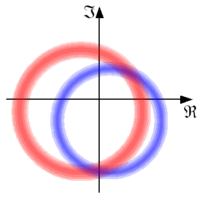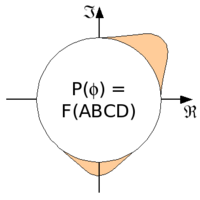Hendrickson Lattman coefficients
From Media Wiki
Hendrickson-Lattman coefficients are a set of 4 numbers, represented by the symbols A, B, C and D, which provide a compact description of a bimodal phase probability distribution. The phase probability given by the coefficients as a function of φ is geven by the formula:
P(φ) = N exp( A cos(φ) + B sin(φ) + C cos(2φ) + D sin(2φ) )
where N is a normalisation constant such that ∫ P(φ) dφ = 1.
SIR and SAD phasing both lead to a phase ambiguity which means that there is no single 'best phase' which represents the result of the phasing calculation. Since Hendrickson-Lattman coefficients can model a bimodal phase probability distribution, they can provide a good description of such a distribution.
The A and B coefficients represent a unimodal phase probability distribution, whose centred on the phase φ = atan(B/A).
The C and D coefficients modulate this distribution with a second, symmetrical biomdal distribution. The combination of these two distributions is a general biomodal distribution.
If C and C are zero, then the Hendrickson-Lattman distribution is identical to the distribution represented by a Best phase and Figure of merit. The relationship is as follows: A = X cos( φbest ), B = X sin( φbest ), where FOM = tanh(X/2) (centric) and FOM = I1(X)/I0(X) (acentric).
--Kevin Cowtan 06:04, 18 April 2008 (CDT)

